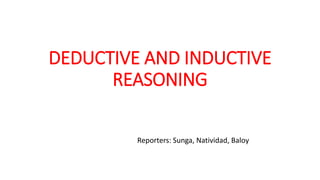Deductive And Inductive Reasoning
•Download as PPTX, PDF•
2 likes•923 views
This power point was created for a cognitive psychology report.
Report
Share
Report
Share

Recommended
More Related Content
What's hot
What's hot (20)
Similar to Deductive And Inductive Reasoning
Similar to Deductive And Inductive Reasoning (20)
Mathematical Reasoning (unit-5) UGC NET Paper-1 Study Notes (E-books) Down...

Mathematical Reasoning (unit-5) UGC NET Paper-1 Study Notes (E-books) Down...
1.1Arguments, Premises, and ConclusionsHow Logical Are You·.docx

1.1Arguments, Premises, and ConclusionsHow Logical Are You·.docx
1.1Arguments, Premises, and ConclusionsHow Logical Are You·.docx

1.1Arguments, Premises, and ConclusionsHow Logical Are You·.docx
More from Veniez Sunga
More from Veniez Sunga (6)
Recently uploaded
MuleSoft Integration with AWS Textract | Calling AWS Textract API |AWS - Cloud Native Meetup #4
Event Link:-
https://meetups.mulesoft.com/events/details/mulesoft-aws-cloud-native-presents-unveiling-the-heart-of-mulesoft-intelligent-document-processing-aws-textract/
Agenda
● Introduction to Textract
● Document Processing using AWS Textract
● AWS Textract UseCases
● AWS Textract API
● Calling AWS Textract API from Postman
● Demo - Textract Integration with MuleSoft
● QnA
◈ Important Links
https://aws.amazon.com/textract/resources/
https://docs.aws.amazon.com/textract/latest/dg/API_AnalyzeDocument.html
https://docs.aws.amazon.com/general/latest/gr/textract.html
https://docs.aws.amazon.com/IAM/latest/UserGuide/reference_aws-signing.html
https://ambassadorpatryk.com/2021/01/discover-how-to-sign-aws-api-request-using-dataweave/
https://github.com/djuang1/awsv4auth-extension
For Upcoming Meetups Join AWS - Cloud Native Meetup Group - https://meetups.mulesoft.com/aws-cloud-native/
Youtube:- youtube.com/@mulesoftmysore
Mysore WhatsApp group:- https://chat.whatsapp.com/EhqtHtCC75vCAX7gaO842N
Speaker:-
Shubham Chaurasia - https://www.linkedin.com/in/shubhamchaurasia1/
Priya Shaw - https://www.linkedin.com/in/priya-shaw
Organizers:-
Shubham Chaurasia - https://www.linkedin.com/in/shubhamchaurasia1/
Robin Sinha - https://www.linkedin.com/in/robin-sinhaMuleSoft Integration with AWS Textract | Calling AWS Textract API |AWS - Clou...

MuleSoft Integration with AWS Textract | Calling AWS Textract API |AWS - Clou...MysoreMuleSoftMeetup
Recently uploaded (20)
Transparency, Recognition and the role of eSealing - Ildiko Mazar and Koen No...

Transparency, Recognition and the role of eSealing - Ildiko Mazar and Koen No...
HMCS Max Bernays Pre-Deployment Brief (May 2024).pptx

HMCS Max Bernays Pre-Deployment Brief (May 2024).pptx
MuleSoft Integration with AWS Textract | Calling AWS Textract API |AWS - Clou...

MuleSoft Integration with AWS Textract | Calling AWS Textract API |AWS - Clou...
Graduate Outcomes Presentation Slides - English (v3).pptx

Graduate Outcomes Presentation Slides - English (v3).pptx
21st_Century_Skills_Framework_Final_Presentation_2.pptx

21st_Century_Skills_Framework_Final_Presentation_2.pptx
How to Send Pro Forma Invoice to Your Customers in Odoo 17

How to Send Pro Forma Invoice to Your Customers in Odoo 17
Spring gala 2024 photo slideshow - Celebrating School-Community Partnerships

Spring gala 2024 photo slideshow - Celebrating School-Community Partnerships
Michaelis Menten Equation and Estimation Of Vmax and Tmax.pptx

Michaelis Menten Equation and Estimation Of Vmax and Tmax.pptx
Deductive And Inductive Reasoning
- 1. DEDUCTIVE AND INDUCTIVE REASONING Reporters: Sunga, Natividad, Baloy
- 2. What Is Deductive Reasoning? • Deductive reasoning is the process of reasoning from one or more general statements regarding what is known to reach a logically certain conclusion. • One of the primary types of deductive reasoning is conditional reasoning, in which the reasoners must draw a conclusion based on an if-then proposition.
- 3. What Is Inductive Reasoning? • Inductive reasoning is the process of reasoning from specific facts or observations toreach a likely conclusion that may explain the facts. The inductive reasoners thenmay use that probable conclusion to attempt to predict future specific instances • The key feature distinguishing inductive from deductive reasoning is that, in inductive reasoning, we never can reach a logically certain conclusion. We only can reach a particularly well-founded or probable conclusion.
- 4. Causal Inferences • One approach to studying inductive reasoning is to examine causal inferences—how people make judgments about whether something causes something else • First one thing happens, then another. If we see the two events paired enough, we may come to believe that the first causes the second. • We demonstrate confirmation bias, which may lead us to errors • Correlational evidence cannot indicate the direction • of causation. Suppose we observe a correlation between Factor A and Factor B. We may find one of three things: 1. it may be that Factor A causes Factor B; 2. it may be that Factor B causes Factor A; or 3. some higher order, Factor C, may be causing both Factors A and B to occur together.
- 5. Reasoning by Analogy • Inductive reasoning may be applied to a broader range of situations than those requiring causal or categorical inferences. For example, inductive reasoning may be applied to reasoning by analogy. Consider an example analogy problem: Fire is to asbestos as water is to: (a) vinyl, (b) air, (c) cotton, (d) faucet. In reasoning by analogy, the reasoner must observe the first pair of items (“fire” and “asbestos” in this example) and must induce from those two items one or more relations (in this case, surface resistance because surfaces coated with asbestos can resist fire). The reasoner then must apply the given relation in the second part of • the analogy. In the example analogy, the reasoner chooses the solution to be “vinyl” because surfaces coated with vinyl can resist water
- 6. • The difficulty of encoding can become even greater in various puzzling analogies. For example, in the analogy: RAT : TAR :: BAT : (a. CONCRETE, b. MAMMAL, c. TAB, d. TAIL)
- 7. Neuroscience of Reasoning • As in both problem solving and decision making, the process of reasoning involves the prefrontal cortex (Bunge et al., 2004). Further, reasoning involves brain areas associated with working memory, such as the basal ganglia (Melrose, Poulin, & Stern, 2007). One would expect working memory to be involved because reasoning involves the integration of information (which needs to be held in working memory while it is being integrated). • The basal ganglia are involved in a variety of functions, including cognition and learning. This area is also associated with the prefrontal cortex through a variety of connections (Melrose, Poulin, & Stern, 2007).